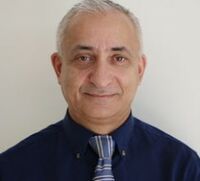East Auckland, South Auckland > Private Hospitals & Specialists >
Franklin Hospital Endoscopy
Private Surgical Service, Endoscopy (Gastroenterology), Gastroenterology & Hepatology (Liver), General Surgery
Description
Consultants
-

Dr Paul Casey
Gastroenterologist, Endoscopist & Hepatologist
-

Dr Stephen Gerred
Gastroenterologist, Endoscopist & Hepatologist
-

Dr Dinesh Lal
Gastroenterologist, Hepatologist, Interventional Endoscopist, ERCPist
-

Dr Ravinder Ogra
Gastroenterologist & Interventional Endoscopist
-

Ms Sze-Lin Peng
Colorectal Surgeon
-

Dr Stephen Persson
Gastroenterologist, Hepatologist, Interventional Endoscopist, ERCPist
How do I access this service?
Referral
General Practitioners can refer patients directly to Franklin Hospital's endoscopy service, without patients needing to consult with a specialist first, by any of the following methods:
- Email:
- GP Referrals: 09 220 4805
- Complete the Endoscopy Procedure Referral Form and email as above
- Contact endoscopist directly via the Specialists & Referrals site
Make an appointment
Please have the following ready before you make a booking for your procedure:
- Referral letter
- Health insurance provider details (if applicable)
- GP name and practice
Fees and Charges Description
If you have private health insurance, please arrange your prior approval with them before your procedure (except Southern Cross members as we will apply for approval on your behalf). You must bring your insurance prior approval letter with you to this appointment.
If your procedure is not covered by insurance, we will calculate an estimated total cost of your procedure which will be charged on your arrival. Dependant on consumables used during your procedure, there may be additional payment required on discharge.
Procedures / Treatments
Endoscopy is the process of looking inside body cavities, using a very tiny camera attached to the end of a long, flexible tube (endoscope). Images from the camera are sent to a television monitor so that the doctor can direct the movement of the endoscope. It is also possible to pass different instruments through the endoscope to allow small samples or growths to be removed. Endoscopy allows a doctor to make a diagnosis either by seeing directly what is causing the problem or by taking a small tissue sample for examination under a microscope (biopsy). Endoscopy can also be used as a treatment e.g. for removal of swallowed objects in the oesophagus (food pipe), healing of lesions etc.
Endoscopy is the process of looking inside body cavities, using a very tiny camera attached to the end of a long, flexible tube (endoscope). Images from the camera are sent to a television monitor so that the doctor can direct the movement of the endoscope. It is also possible to pass different instruments through the endoscope to allow small samples or growths to be removed. Endoscopy allows a doctor to make a diagnosis either by seeing directly what is causing the problem or by taking a small tissue sample for examination under a microscope (biopsy). Endoscopy can also be used as a treatment e.g. for removal of swallowed objects in the oesophagus (food pipe), healing of lesions etc.
Endoscopy is the process of looking inside body cavities, using a very tiny camera attached to the end of a long, flexible tube (endoscope). Images from the camera are sent to a television monitor so that the doctor can direct the movement of the endoscope. It is also possible to pass different instruments through the endoscope to allow small samples or growths to be removed.
Endoscopy allows a doctor to make a diagnosis either by seeing directly what is causing the problem or by taking a small tissue sample for examination under a microscope (biopsy).
Endoscopy can also be used as a treatment e.g. for removal of swallowed objects in the oesophagus (food pipe), healing of lesions etc.
This is a procedure which allows the doctor to see inside your oesophagus, stomach, and the first part of the small intestine (duodenum) and examine the lining directly. What to expect The gastroscope is a plastic-coated tube about as thick as a ballpoint pen and is flexible. It has a tiny camera attached that sends images to a viewing screen. During the test you will swallow the tube but the back of your throat is sprayed with anaesthetic so you don’t feel this. You will be offered a sedative (medicine that will make you sleepy but is not a general anaesthetic) as well. If the doctor sees any abnormalities they can take a biopsy (a small piece of tissue) to send to the laboratory for testing. This is not a painful procedure and will be performed at the day stay unit in a theatre suite (operating room) by a specialist doctor with nurses assisting. Complications from this procedure are very rare but can occur. They include: bleeding after a biopsy, if performed an allergic reaction to the sedative or throat spray perforation (tearing) of the stomach with the instrument (this is a serious but extremely rare complication). Before the procedure You will be asked not to eat anything from midnight the night before and not to take any of your medications on the day of the procedure. After the procedure You will stay in the day stay unit until the sedation has worn off which usually takes 1-2 hours. You will be given something to eat or drink before you go home. If you have been sedated, you are not to drive until the following day. If biopsies are taken these will be sent for analysis and results are available within 2-3 weeks. A report and copies of these are sent to your GP.
This is a procedure which allows the doctor to see inside your oesophagus, stomach, and the first part of the small intestine (duodenum) and examine the lining directly. What to expect The gastroscope is a plastic-coated tube about as thick as a ballpoint pen and is flexible. It has a tiny camera attached that sends images to a viewing screen. During the test you will swallow the tube but the back of your throat is sprayed with anaesthetic so you don’t feel this. You will be offered a sedative (medicine that will make you sleepy but is not a general anaesthetic) as well. If the doctor sees any abnormalities they can take a biopsy (a small piece of tissue) to send to the laboratory for testing. This is not a painful procedure and will be performed at the day stay unit in a theatre suite (operating room) by a specialist doctor with nurses assisting. Complications from this procedure are very rare but can occur. They include: bleeding after a biopsy, if performed an allergic reaction to the sedative or throat spray perforation (tearing) of the stomach with the instrument (this is a serious but extremely rare complication). Before the procedure You will be asked not to eat anything from midnight the night before and not to take any of your medications on the day of the procedure. After the procedure You will stay in the day stay unit until the sedation has worn off which usually takes 1-2 hours. You will be given something to eat or drink before you go home. If you have been sedated, you are not to drive until the following day. If biopsies are taken these will be sent for analysis and results are available within 2-3 weeks. A report and copies of these are sent to your GP.
- bleeding after a biopsy, if performed
- an allergic reaction to the sedative or throat spray
- perforation (tearing) of the stomach with the instrument (this is a serious but extremely rare complication).
This is a procedure which allows the doctor to see inside your large bowel and examine the surfaces directly and take biopsies (samples of tissue) if needed. Treatment of conditions can also be undertaken. What to expect The colonoscope is a flexible plastic-coated tube a little thicker than a ballpoint pen which has a tiny camera attached that sends images to a viewing screen. You will be given a sedative (medicine that will make you sleepy but is not a general anaesthetic). The tube is passed into the rectum (bottom) and gently moved along the large bowel. The procedure takes from 10 minutes to 1 hour and your oxygen levels and heart rhythm are monitored throughout. The procedure is performed in a day stay operating theatre. Before the procedure You will need to follow a special diet and take some laxatives (medicine to make you go to the toilet) over the days leading up to the test. Risks of a colonoscopy are rare but include: bleeding if a biopsy is performed allergic reaction to the sedative perforation (tearing) of the bowel wall.
This is a procedure which allows the doctor to see inside your large bowel and examine the surfaces directly and take biopsies (samples of tissue) if needed. Treatment of conditions can also be undertaken. What to expect The colonoscope is a flexible plastic-coated tube a little thicker than a ballpoint pen which has a tiny camera attached that sends images to a viewing screen. You will be given a sedative (medicine that will make you sleepy but is not a general anaesthetic). The tube is passed into the rectum (bottom) and gently moved along the large bowel. The procedure takes from 10 minutes to 1 hour and your oxygen levels and heart rhythm are monitored throughout. The procedure is performed in a day stay operating theatre. Before the procedure You will need to follow a special diet and take some laxatives (medicine to make you go to the toilet) over the days leading up to the test. Risks of a colonoscopy are rare but include: bleeding if a biopsy is performed allergic reaction to the sedative perforation (tearing) of the bowel wall.
- bleeding if a biopsy is performed
- allergic reaction to the sedative
- perforation (tearing) of the bowel wall.
A long, narrow tube with a tiny camera attached (sigmoidoscope) is inserted into your anus and moved through your lower large intestine (bowel). This allows the surgeon a view of the lining of the lower large intestine (sigmoid colon). If necessary, a biopsy (small piece of tissue) may be taken for examination in the laboratory.
A long, narrow tube with a tiny camera attached (sigmoidoscope) is inserted into your anus and moved through your lower large intestine (bowel). This allows the surgeon a view of the lining of the lower large intestine (sigmoid colon). If necessary, a biopsy (small piece of tissue) may be taken for examination in the laboratory.
A long, narrow tube with a tiny camera attached (sigmoidoscope) is inserted into your anus and moved through your lower large intestine (bowel). This allows the surgeon a view of the lining of the lower large intestine (sigmoid colon). If necessary, a biopsy (small piece of tissue) may be taken for examination in the laboratory.
A flexible tube with a tiny video camera attached (endoscope) is inserted through the mouth into the stomach and small intestine while you are under sedation (you have been given medication to make you drowsy). A smaller tube is then moved through the first tube into the bile duct (the tube that connects your gallbladder to your intestines) through which dye is injected and an x-ray is taken to visualise the ducts. This procedure also enables the removal of stones from the ducts without the need for surgery.
A flexible tube with a tiny video camera attached (endoscope) is inserted through the mouth into the stomach and small intestine while you are under sedation (you have been given medication to make you drowsy). A smaller tube is then moved through the first tube into the bile duct (the tube that connects your gallbladder to your intestines) through which dye is injected and an x-ray is taken to visualise the ducts. This procedure also enables the removal of stones from the ducts without the need for surgery.
Click here for information about the Orbera® managed weight loss system.
Click here for information about the Orbera® managed weight loss system.
Click here for information about the Orbera® managed weight loss system.
Website
Contact Details
Franklin Hospital, 12 Glasgow Road, Pukekohe, Auckland
South Auckland
-
Phone
(09) 220 4800
Email
Website
12 Glasgow Road
Pukekohe
Auckland 2120
Street Address
12 Glasgow Road
Pukekohe
Auckland 2120
Postal Address
P.O. Box 428
Pukekohe
2340
Was this page helpful?
This page was last updated at 2:56PM on April 9, 2024. This information is reviewed and edited by Franklin Hospital Endoscopy.

